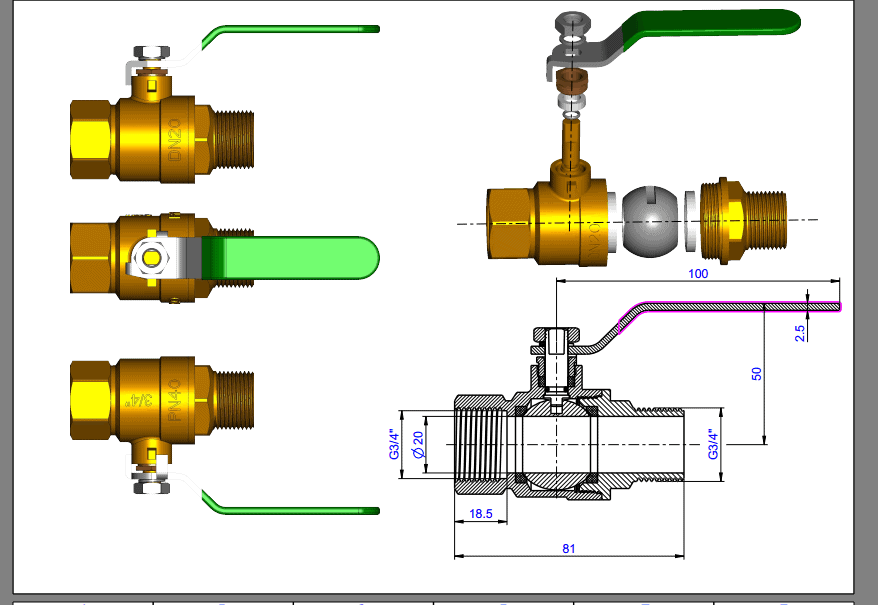The Ball valve is arguably the most used and popular. And there are good enough reasons behind this. People love to use it because of its variety of unique types and benefits. You may see or use them daily in different applications but never recognize them. Read on to learn everything about ball valves.
The Ball valve is a mechanical device used to control and direct the flow of various substances. In other words, it is a valve with a ball with a hole at its center that can open, close, and direct the media flow. It controls the flow with a lever and the rotation of the ball. The water bibcock (lever-type) in your house or garden is the best example of a ball valve.
Types Of Ball Valve
Brass Ball valves come in a variety of types with unique features. These types are made depending on many criteria, such as:
Body Construction: 1-piece, 2-piece, and 3-piece body. Here, body pieces define the number of body sections the valve has. For example, a 3-piece ball valve has two pipe connectors and the main body.
A number of ports: 2 and 3. The standard type is 2 ports, 1 inlet, and 1 outlet. But the 3 port design allows you to use 2 ports as inlet and 1 as outlet or vice-versa.
Ball Hole Size: Full bore, Reduced bore, and V-shaped. The diameter of a full-bore valve equals the pipe’s diameter. The reduced bore valve has a smaller hole than the pipe hole. And as the name implies, the ball of the V-shaped valve has a V-shaped design hole.
Ball Design: Floating and Trunnion Mounted. The ball floats inside of the valve in a floating ball valve. And the Trunnion is similar to the floating one but with spring-loaded seats.
Operation: Manual and Electric or Motorized. Most of the ball valves are operated manually. However, new types of electrical components are available that can be used automatically.
Ball Access: Side-entry and Top-entry. The entry direction specifies which side you can access the interior of the valve.
Ball Valve Parts
A ball valve is made with different types of small components. Here is a summary of regular-type ball valve parts:
Firstly, you will notice a flattened Handle attached to the valve when you look at it. But sometimes, you will see a spinning handle instead of that sliding handle. The handle has a Nut with a Thrust Washer on the above. These two help to tighten the handle with the valve. Secondly, right underneath the handle, there is a Gland Nut. The gland nut ensures the watertight seal to prevent leakage while the system is on.
In addition, a metal rod named Steam connects the upper mechanism with the Rotary Ball inside the valve. The rotary ball is a round steel ball with a bore (hole) inside. It’s on the right in the middle of the valve body, while the two O-shaped seats surround it on both sides. You can consider the rest you see outside as the valve body. It has two ends: one is the inlet, and the other is the outlet. That is all a regular-type ball valve consists of. However, only the upper parts have been changed to motorized ones. The electrical component replaces the handle to automate the valve.

How Does A Ball Valve Work?
A ball valve manages the flow of the substances and flow direction. The multi-port (3-way) valves can mix multiple media and send it in different directions. It does this with a brass rotary ball. Let’s see how.
It is a straightforward but effective trick. If the valve is closed, the ball hole is set opposite. When you slide the handle from 0 to 90 degrees, it will rotate the ball. Therefore, the ball holes will meet with the inlet and outlet holes. This will create a path for the media to flow. Finally, the media or substances will flow without any interruption.
Again, when you slide the handle in reverse, it will rotate back the ball. After that, the ball hole will move and seal the drain. As a result, the flow will stop. This is how a ball valve works.
Ball Valve Benefits
Ball valves have several distinct advantages over other types of valves. Such as:
- It supports almost all types of media and ensures reliable sealing.
2. The structure is simple, so you can easily disassemble and repair it.
3. You can efficiently operate the valve by simply rotating the handle. Also, it offers quick on-off, which is very helpful in case of emergency.
4. Have a low-pressure drop and a reasonable rate of flow capacity.
5. The chances of corrosion or damage are low, so that it will serve you for a long time.
6. Available at low prices.

Uses
The demand for Ball valves is expanding worldwide due to their various forms and excellent benefits. You can use them anywhere, from your home’s water bibcock to big industrial pipelines. For example, our daily life applications, like washing machines, dishwashers, plumbing systems, and outdoor hoses, use ball valves to control water flow. Also, industries such as oil, natural gas, pharmaceutical, Hot stamping machine manufacturing, vehicle wash systems, chemical, automotive, and many others… use ball valves for different purposes.
Above all, you have got a crystal clear idea about ball valves. And if you are about to set up a new application or something related, you will need ball valves. You have many options, but think carefully and choose the one that fits your needs.
Moreover, if you are considering buying and importing ball valves, do not forget the name Plumberstar. We, Plumberstar, are a professional brass valve manufacturer and supplier based in China. We have many other valves that will meet your needs, including high-quality ball valves. Without believing our words, see our products yourself and decide.
